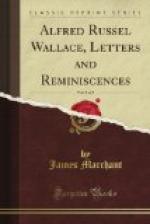ALFRED R. WALLACE.
* * * * *
In the discussion on Prof. Barrett’s paper at the Glasgow Meeting of the British Association, which took place in the London Times and other newspapers, instances of apparent thought-transference were given by many correspondents. Each of these cases Prof. Barrett investigated personally, and one of them led to a remarkable series of experiments which he conducted at Buxton, with the result that no doubt was left on his mind of the fact of the transference of ideas from one mind to another independent of the ordinary channels of sense. He asked Prof. and Mrs. H. Sidgwick to come to Buxton and repeat his experiments with the subjects there—daughters of a local clergyman. They did so, and though they had less success at first than Prof. Barrett had had, they were ultimately convinced of the genuineness of the phenomena. In addition, Mr. Edmund Gurney, Mr. Frederic Myers, Prof. A. Hopkinson and Prof. Balfour Stewart, all responded to Prof. Barrett’s invitation to visit Buxton and test the matter for themselves, and all came to the same conclusion as he had. Subsequently Gurney and Myers associated their name with Barrett’s in a paper on the subject, published in the Nineteenth Century.
Prof. Barrett asked Wallace to read over the first report made by Prof. and Mrs. Sidgwick, which at first seemed somewhat disheartening, and the following is his reply:
REMARKS ON EXPERIMENTS IN THOUGHT READING BY MR. AND MRS. SIDGWICK AT BUXTON
The failure of so many of these experiments seems to me to depend on their having been conducted without any knowledge of the main peculiarity of thought reading or clairvoyance—that it is a perception of the object thought of or hidden, not by its name, or even by its sum total of distinctive qualities, but by the simple qualities separately. A clairvoyant will perceive a thing as round, then as yellow, and finally as an orange. Now Mr. Galton’s experiments have shown how various are the powers of visualising objects possessed by different persons, and how distinct their modes of doing so; and if these distinct visualisations of the same thing are in any way presented to a clairvoyant, there is little wonder that some confusion should result. This would suggest that one person who possesses the faculty of clearly visualising objects would meet with more success than a number of persons some of whom visualise one portion or quality of the object, some another, while to others the name alone is present to the mind. It follows from these considerations that cards are bad for such experiments. The qualities of number, colour, form and arrangement may be severally most prominent in one mind or other, and the result is confusion to the thought reader. This is shown in the experiments by the number of pips or the suit alone being often right.




